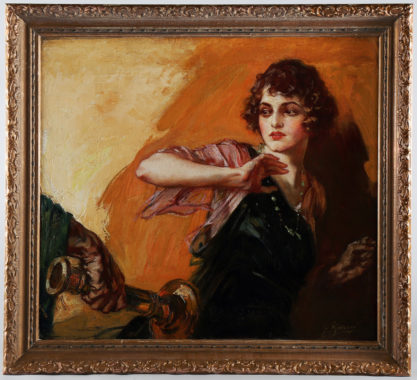

A dramatically conceived illustration by the prolific New York based early twentieth century illustrator P. J. Monahan–this was likely created as cover art for an as-of-yet-unidentified pulp magazine. A flapper girl damsel in distress in dramatic light and shadow recoils as she attempts to fend off a man attacking her with a large brass candlestick. Painting is in a period gold frame and is signed in the lower right corner and titled “Fear” on the verso in the artist’s hand, with an additional label that has the artist’s New York City street address.




P. J. Mohahan
Patrick John Sullivan (Monahan) was born in Des Moines, Iowa, on January 4, 1882. Patrick won a four-year art scholarship to Drake University of Ministers where his artistic talent bloomed. This talent won him a first prize at the St. Louis Exposition and the opportunity to further his art studies in Europe, where he went on to win more awards and even painted a full-figure painting of Pope Pius X. After graduation he worked as a newspaper illustrator in Chicago and St. Louis.
On October 24, 1905, Patrick married Louise Cecelia Averill, after the birth of their first child, Cecelia, they moved to New York where Patrick worked at illustrating fashion catalogues. His reputation grew and soon he was painting covers for Leslie’s Weekly, The New Broadway Magazine, The Delineator, and Judge Magazine. In 1909 his work was featured with that of 16 other top artists to appear in the collection, “Judge Art Prints.”
This led to work for “the slick” magazines and by 1911 he was doing interiors for The Ladies Home Journal, Cosmopolitan, Leslie’s Weekly, Pearson’s Magazine, The Hearst Magazine and Hampton’s. He kept a small studio in New York in the Printers Craft Building, and by 1912 he was doing cover work for syndicated newspapers across America. He was invited to become a member in the Society of Illustrators headed by Charles Dana Gibson (creator of the “Gibson Girl”) and became friends with artists such as James Montgomery Flagg, Norman Rockwell and many other top artists of the day. Contracts with Street and Smith Publications provided steady employment for titles such as: Air Trails, Western Story Magazine, Detective Story Magazine, People’s Magazine, etc. His imaginative composition, design, use of colors and his stimulating images full of romance and adventure were soon providing ideal illustrations for Munsey’s stable of adventure writers: Edgar Rice Burroughs, Rex Stout, H. Bedford Jones, Frank L. Packard, J. Allen Dunn and George Allan England. Soon he was producing color cover paintings ($125 each) for the Munsey pulp magazines: Munsey Magazine, Argosy, All-Story, Cavalier, and Railroad Man’s Magazine.
In 1912, Robert H. Davis and Thomas Metcalf of The All-Story Magazine published the first installment of an unknown writer’s first novel: Under the Moons of Mars in the February issue. Response for this unique romantic science fiction tale was so overwhelming that they followed it up in the October issue with another of the author’s highly imaginative tales — Tarzan of the Apes — with a cover illustration by Clinton Pettee. This proved to be the start of a new era of pulp fiction in which P. J. Monahan would play a major part.
Through all his work for society magazines and fashion catalogues, Monahan had developed a special skill in the painting of women. This talent would serve him well in the crafting of pulp adventure covers. Monahan’s colouful heroines exuded an air of innocence, femininity, and romance that appealed to both sexes. He also did all his own lettering — and was often called upon to paint over the original magazine lettering to adapt the paintings for use on dust jackets for hardcover book releases.
Besides this regular work he freelanced for even more magazines — Adventure, Woman’s Magazine, Pictorial Review, The Designer, Colliers — and doing covers and interior illustrations for numerous books.
